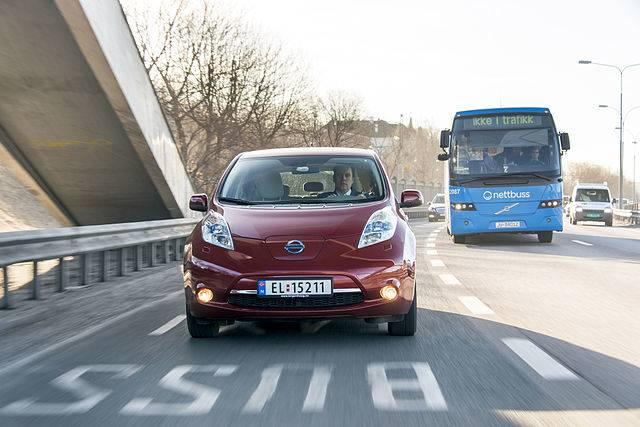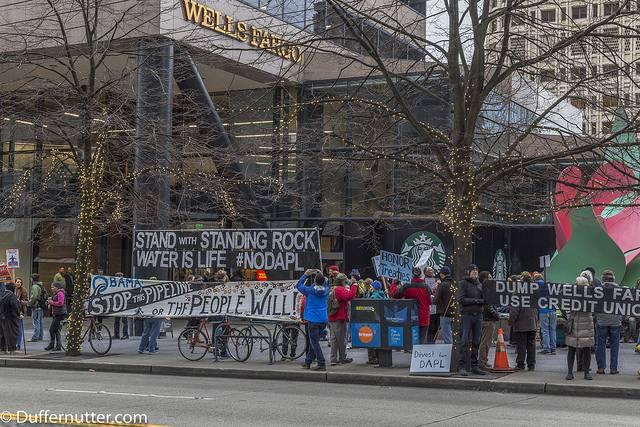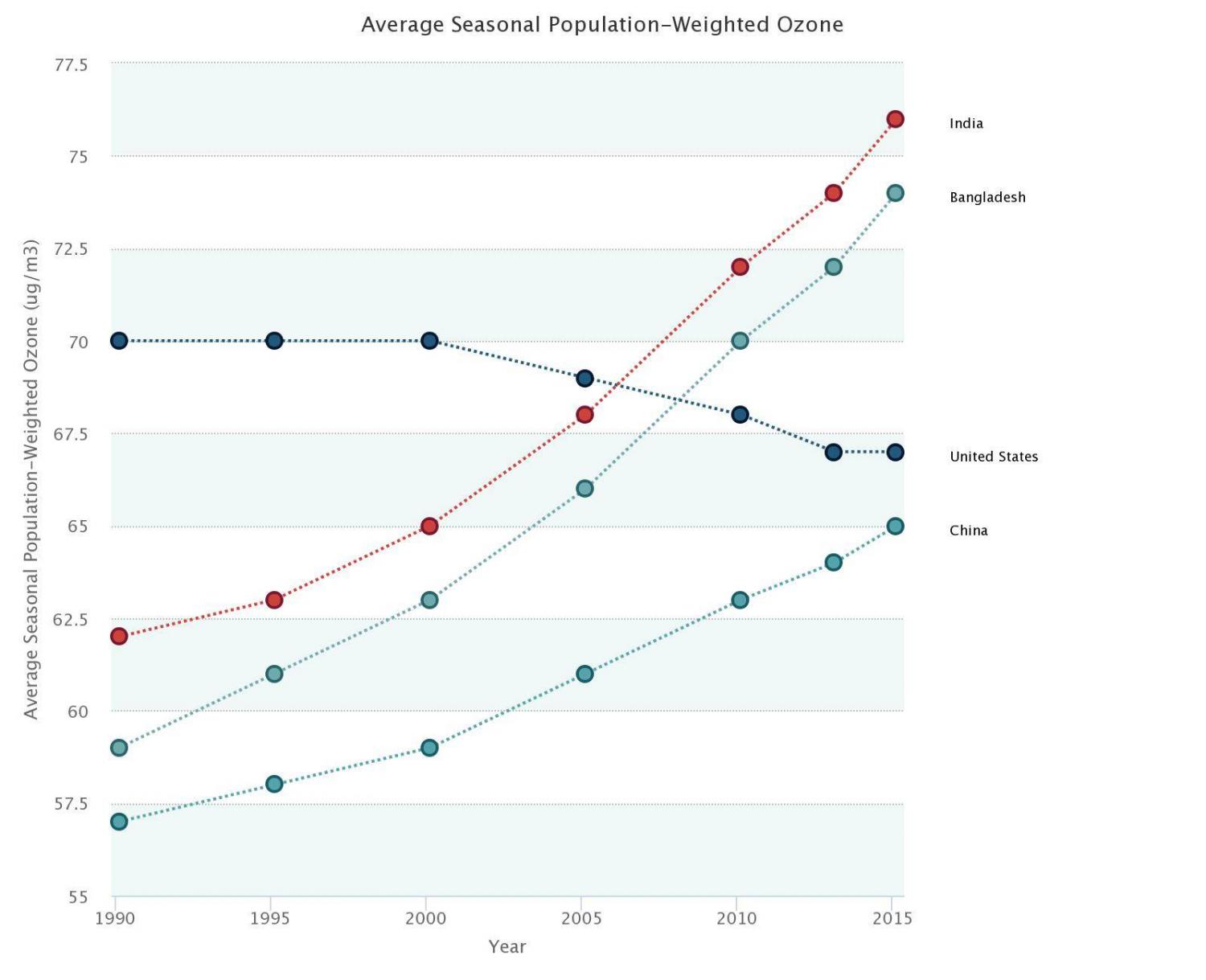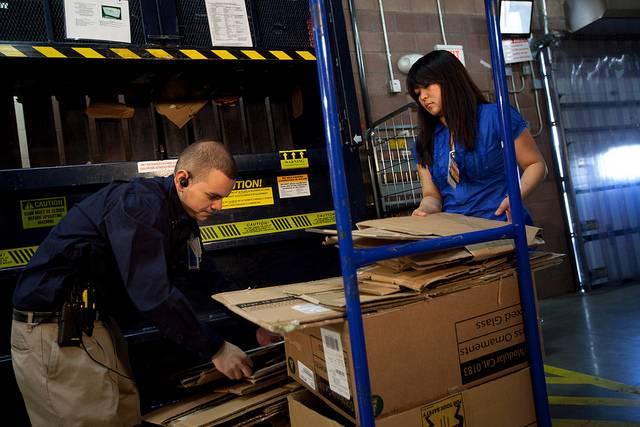Norway Expands Its Role as the World’s Electric Vehicle Leader


Although battery range is improving and designs are more appealing, electric vehicles still face a long road ahead in order to gain drivers’ acceptance. The 30-month-long slump in petroleum prices is not helping; neither is range anxiety (the fear of being stranded on a roadside with no electric power). In most industrialized nations, electric cars have a market share of around 1 percent at best.
But oil-rich Norway continues to dominate when it comes to battery-powered cars.
Norway welcomed its 100,000th all-electric car in December. And 2016 concluded with sales of over 130,000 new vehicles that either have an all-electric drive train or are a plug-in hybrids (PHEVs), according to the Norway EV Association. That is triple the amount of electric cars on Norway’s cars just two years earlier.
In 2015, the New York Times estimated that electric car had only a 2 percent market share in Norway – which was still good enough to double that of the global runner-up, the Netherlands. But last year beat records, and the trend continued into 2017.
Sales of electric cars continued to surge last month, with all-electric models making up 37 percent of all new cars sold, the automotive blog Electrek reported this week. Over 350 Tesla models were delivered last month within the country of 5 million people. And newer models, such as the Hyundai Ioniq Electric, continue to make their debut in Norway -- where the registration of new electric cars far outpaces other European countries.
Despite all that growth, electric car sales still only account for about 5 percent of all the automobiles in Norway, The Economist reported. Nevertheless, sales of electric vehicles are expected to surge in the coming years, especially as their designs become more appealing and their range keeps extending.
So, what is Norway's secret to electrified roadways?
Norway’s government has been aggressively pushing incentives for electric cars since the late 1990s. Electric vehicles are exempt from the high value added taxes (VAT) that make conventional automobiles far more pricey in Norway than in other industrialized countries. Electric car drivers also avoid paying road tolls, they can park in city centers for free, and they also have access to bus lanes. In addition, municipalities including the country’s capital, Oslo, offer financial support to install charging stations in neighborhoods or aside office buildings if they are lacking.
The allure of purchasing an electric car was so attractive that the Norwegian government moved to slash incentives in 2015 after its goal of selling 50,000 EVs was achieved three years early. Many of those generous perks, however, were reintroduced last year and have been extended.
Some analysts suggest the growing popularity of electric cars means they will dominate Norway’s streets within a decade – making the country's proposed ban of fossil fuel-powered cars by 2025 unnecessary.
Norway’s push to have citizens drive all-electric cars complements the country’s sustainability agenda.
The country’s sovereign wealth fund divested from coal companies last. And the city of Oslo aims to halve its carbon emissions by 2020, a task that should be easier to achieve as electric cars become even more popular.
In the meantime, watch for electric vehicles to remain central to Norway’s drive to become less dependent on fossil fuels, as the country continues to open more charging stations while aiming to register 400,000 all-electric vehicles by 2020.
Image credit: Norsk Elbilforening/Wiki Commons
Vizio Fined For Spying On Customers Through Their TVs


Vizio is one of the world's biggest manufacturers of plasma and flatscreen televisions, but that's not the only way the company was making money. The electronics giant tracked customers' watching habits and sold that data for a profit, all without informing users, according to a recent investigation.
Earlier this month, the Federal Trade Commission (FTC) fined Vizio for collecting data through its branded smart TVs without properly informing consumers. From the FTC and New Jersey Attorney General’s official statement.
"Vizio smart TVs ... [captured] second-by-second information about video displayed on the smart TV, including video from consumer cable, broadband, set-top box, DVD, over-the-air broadcasts, and streaming devices."In addition, Vizio facilitated appending specific demographic information to the viewing data, such as sex, age, income, marital status, household size, education level, home ownership, and household value, the agencies allege. Vizio sold this information to third parties, who used it for various purposes, including targeting advertising to consumers across devices."
Few customers knew they were being tracked so thoroughly through their TV habits. Our data is valuable and, too often, we have no control over it.
While the FTC ruled unanimously that Vizio violated regulations, the fine seems paltry: $1.5 million to the FTC and $2.2 million to New Jersey. That's for 11 million televisions sold and 100 billion data points captured each year. Does the fine come close to covering the cost of the privacy violated? And does it even bite into Vizio's profiteering from the selling of our viewing data?
As TechCrunch reported last week, a single user and his or her data is valued between $15 and $40. The fine ended up costing Vizio less than 15 cents per TV sold. And it is likely the company sold user data for more than that.
And it's not just Vizio. Samsung and LG TVs similarly track user data, often with their consent during the setup process – through one of those long statements that few read and almost all to. Samsung TVs now have audio recording capabilities – ostensibly, to listen to our commands, but some fear it could be used to spy on users in their homes.
“Most smart TVs are capable of gathering and sending personal information about your and your family’s viewing habits and you might not even be aware – but there are measures you can take to protect yourself,” Wayde Robinson with Audioholics wrote in an editorial.
What are those measures? Robinson advises opting out of data-sharing, purchasing products from companies that value privacy, and limiting use of social media through smart TVs.
The challenge – it’s not just your TV that can spy on you. Soon, it might be everything. We're entering a brave new world, where technology can track our every move, without notifying us.
Smart TVs are just the start: What about a smart fridge that tracks what you eat? Smart cars that tell companies where you go? All are coming, part of the so-called Internet of Things, and few have proper, consumer-friendly privacy-protection regulations to accompany them. The U.S. government has openly stated it would use these products to spy on us.
Unless we work to get stronger privacy laws in, the Vizio case could be the first of many instances of companies using our data for profit – without our acknowledgement. It is long past time that technology companies take user privacy seriously.
Image credit: kennejima via Flickr
Calls For Divestment From the Dakota Access Pipeline Reach a Roar


It's not a popular time for banks that have agreed to back the Dakota Access Pipeline. Cities and other public entities are ending business with banks like Wells Fargo, which loaned more than $400 million to the pipeline's developers. And the divestment movement is growing.
Last week Seattle and the California city of Davis announced they would stop doing business with Wells Fargo.
This week the city of Alameda, California is mulling divestment. So is the California Public Employee Retirement System, which initially resisted calls for divestment by protesters. The Swedish investment fund Nordea said it will no longer invest in the pipeline on behalf of clients. And New York Mayor Bill de Blasio said he admires Seattle's unilateral move to divest and would consider doing the same.
It is probably no surprise that a number of Native American tribes are also taking steps to divest. The Standing Rock Sioux took steps to divest from financial institutions doing business with the pipeline developers back in August. Since then, a growing number of tribes across the country have either ended business with the 35 banks funding the projects' developers or expressed interest in doing so, Frances Madeson reports in Yes Magazine.
“American Indians have to be able to stand up for what they believe about the environment, the economics of their time, and the social impact of situations like this,” said Lynn Rapp, an investment adviser in Buffalo Gap, South Dakota.
That concern cuts across all economic strata when it comes to native communities, wrote Madeson, who points out that even poor communities see long-term sense in taking a stand against banks that fund DAPL. Duane Yazzie, president of the Shiprock chapter of the Navajo Nation, encouraged his constituents to take a serious financial stand against the pipeline -- one that comes with some sacrifice for the Navajo Nation, where more than 40 percent of people are below the poverty line.
Wells Fargo has found itself at the center of the firestorm against DAPL investments. In response to the growing outcry, the company said the $447 million it advanced toward the pipeline's construction and its developers also have ties to Native American communities in 27 states.
Wells Fargo insists it helped fund scholarships, paid for projects on tribal lands and provided banking services to hundreds of Native American communities. And certainly the prospect of divesting from one of the country's largest banks isn't a light decision for Standing Rock, Shiprock and other native communities.
Back in California, the financial epicenter of much of the divestment movement, a startup devised a way to make the process of divestment faster and easier. Open Invest now offers an app to help people divest from companies funding DAPL and a reminder that change is a social investment.
"There are plenty of ways to support Standing Rock, but we have to remember that almost all of us are individually implicated," the company says. "We are funding the Dakota Access Pipeline."
So far, investors, institutions and individuals have pulled more than $66 million from companies funding either the pipeline or its developers, according to DefundDAPLL.org.
Image credit: Flickr/John Duffy
India’s Air Pollution Catching Up to China as Worst on Earth


India has become one of the world’s hottest solar markets. According to news outlets including Bloomberg, the aggressive renewables goals pushed by Prime Minister Narendra Modi led to 4.5 gigawatts of new solar power capacity last year. That number is expected to almost double this year.
Unfortunately, the surge in India’s clean-energy markets is too late for the approximately 1.1 million citizens who suffer premature deaths linked to air pollution each year, according to a recent study.
The State of Global Air, a joint project of Boston-based Health Effects Institute and Seattle's Institute of Health Metrics and Evaluation (IHME), suggests that annual premature deaths attributed to air pollution have doubled in India since 1990. The overall air quality in country worsened when compared to China, long known for its air pollution problems. And in sheer numbers, India’s air is becoming the deadliest on Earth.
The problem is particulate matter that is 2.5 microns or smaller, generally referred to as PM2.5. According to the study, India and its neighbor, Bangladesh, have seen air pollution levels surge since 2010 and are now burdened with the highest PM2.5 concentrations in the world.
Medical researchers have concluded that exposure to PM2.5 can result in premature death from obvious causes such as lung cancer and respiratory diseases. But because these particles -- which are a fraction of the width of a human hair -- can easily enter the bloodstream, they are also linked to deaths that result from stroke and heart failure.
PM2.5 particles are released by exhaust pipes, especially those connected to diesel engines, industrial sites and cookstoves, the latter of which are still common across rural India. While cities such as Delhi and Mumbai have become notoriously polluted, the use of cookstoves, as well as diesel vehicles and generators, in rural India has also contributed to health problems in these regions. Therefore, while solar has been cheaper than diesel fuel in rural India for several years, the country’s exacerbated health crisis is also helping to make the case for the deployment of more clean-energy development across the country of 1.3 billion people.
But unless cleaner sources of energy can scale across India, watch for deaths related to air pollution to increase for some time. IHME linked 4 million deaths worldwide to PM2.5 in 2015, with over half of those lives claimed in China and India. Both countries anchor a region, one stretching from the Atlantic shores of North Africa across the Middle East and to China, which reports the highest concentration of deaths from PM2.5 exposure.
This same study also found an increase in deaths due to ozone exposure. While the total number of deaths is not nearly as dramatic as the rate of deaths from PM2.5 particles, ozone has also emerged as another large health problem in India. Since 1990, there has been a 60 percent increase in ozone exposure-related deaths, with two-thirds of that increase occurring in India alone.
Several factors explain India’s worsening air quality and its surge in deaths related to pollution.
Its rapidly expanding economy is the envy of much of the world, but that growth has come with a huge social cost. The country’s stubborn poverty, with many rural Indians still lacking reliable access to safe sources of energy, has not helped. But weak legal enforcement is also to blame.
For example, India established its National Green Tribunal as a tool to strengthen the country’s environmental protection. Nevertheless, despite the fact that this environmental court has outlawed common practices such as stubble burning (setting fire to agricultural waste after crops such as grains are harvested), local news outlets report that the practices continue unabated across India, with local officials unwilling or unable to stop them.
Image credit: Leon Kaye
Chart credits: StateOfGlobalAir.org
Russia and U.S.: Partners In Climate Inaction?


Russia just might have its perfect climate change inaction partner in U.S. President Donald Trump, Neela Banerjee of Inside Climate News inferred in a recent analysis. And that could spell disaster for the planet and its inhabitants.
Climate policy in the Trump era
It is highly likely that President Trump will be characterized as active on climate change. The Trump administration wants to free the U.S. “from dependence on foreign oil,” according to its America First Energy Plan. The plan also mentions that the energy industry has “been held back by burdensome regulations,” and commits the Trump administration to eliminating “harmful and unnecessary policies such as the Climate Action Plan.”In other words: Big oil will rule, and climate change action by the federal government will cease.
Trump stated on a number of occasions that he wants to withdraw the U.S. from the Paris climate agreement. And at the end of January, Myron Ebell, who headed the Environmental Protection Agency transition team, said Trump has “made it clear he will withdraw from the Paris Agreement.” Business Insider's Rafi Letzter characterizes Ebell as a man who “spends his time rejecting and trying to discredit scientists who work to understand the global climate.”
The man whom Trump nominated to head the EPA, Scott Pruitt, has sued the agency and other federal agencies more than once over environmental regulations. He is also a climate change denier.
Russia lags behind on climate commitments
Russia is the world’s fifth largest emitter of greenhouse gases, the World Resources Institute, while the U.S. is the second largest.And while Russia signed on to the Paris climate agreement, its climate change commitments were rated inadequate by Climate Action Tracker. Russia’s Intended Nationally Determined Contribution (INDC) has a greenhouse gas emissions reduction target of 25 to 30 percent below 1990 levels by 2030. That sounds great at first. But it's not so impressive after factoring in the considerable emissions decrease that was observed in the early 1990s after the country's economic downturn.
Under this commitment, Russia can increase its emissions until 2030 and not miss its INDC goal, as its 2014 emissions were already 30 percent lower than in 1990, excluding land-use change and forestry. Climate Action Tracker’s analysts say Russia would not have to “implement a single new policy to achieve its current target.”
In order for Russia’s INDC to be rated as “sufficient” by Climate Action Tracker, it would need to be on track to meets its national long-term emissions target of 50 percent below 1990 levels by 2050. For that to happen, Russia would have to adopt a far more ambitious 2030 target.
That is highly unlikely, for Russia is a country whose economy is dependent on oil and gas.
Russia is a petro-state, with oil and gas making up most of the country’s exports. Russia’s sales of crude oil, petroleum products and natural gas accounted for 68 percent of its total export revenues in 2013, according to the U.S. Energy Information Administration. Oil and natural gas activities comprise a large part of Russia’s federal budget. In 2013, 50 percent of its federal budget revenue came from mineral extraction taxes and export custom duties on oil and natural gas.
As a Bloomberg analysis puts it, “Without oil and gas, Russia’s economy would be a shambles.” In the 1990s and again in the past three years, sharp declines in energy prices caused Russia’s economy to have “deep recessions.” A permanent shift away from fossil fuels could kill its economy. If solar power could be stored easily for transportation and night use, it would displace fossil fuels, Bloomberg reported. The price of oil, gas and coal would “crash and never recover, leaving Russia’s economy a wreck.”
Will the U.S. and Russia partner on dirty energy?
Many are speculating that Trump will lift sanction imposed on Russia after the invasion of Crimea. Igor Yusufov, CEO of Russia’s state oil company Rosneft from 2001 to 2004 and Vladmir Putin’s energy minister during his first presidential term, told Climate Change News that closer ties between the U.S. and Russia “would open the doors for massive investment into the Russian oil and gas exploration and production.” He seemed confident that the U.S. would lift sanctions.Yusufov went on to say that while Russia views the Paris agreement “as a cornerstone of the future environmentally conscious world,” his country also knows “that at this stage the Russian economy would not survive without hydrocarbons our companies explore and produce.”
There is a good reason why Trump is likely to lift sanctions on Russia. He has deep ties with that country, going back to the 1980s, as the USA Today reported, among many other outlets. And that could very well open the door for a climate change inaction partnership by the world’s No. 2 and No. 5 greenhouse gas emitters. Meanwhile, climate change impacts are causing floods, droughts and other extreme weather events around the world.
Image credit: Flickr/Mark Dixon
Environmental Managers: Time to Whip out the Balance Sheets


By Noam Gressel
Once upon a time, during the infancy of environmental management, thresholds were all the rage. Regulatory requirements and best practices tended to define “good citizenship” as one that keeps negative impacts, such as release of pollutants, below a certain threshold and positive impacts, such as recycling rates, above another.
There were good reasons for threshold-based accounting: Monitoring devices and wet chemistry methodologies were in their infancy, sporadic and relatively expensive -- requiring focus on a few key impacts and simple “above or below” measures that were more feasible to operate. What’s more, a good part of what was being monitored had to do with acute exposures and with the prevention of risks to onsite employees or nearby communities.
But while these acute exposures remain a concern that must be managed daily, two key factors of this current era suggest we can and we must embrace balance sheet accounting.
For one, technology around us has changed, allowing real-time alerts and automation to cover for acute exposures and minimize their overall share of our impact on the environment. In addition, we’re dealing with a new set of system-based problems, where the name of the game is managing the “load” of pollutants being released or the “flow” of materials or energy being transferred from one location to another.
Climate change is a good case in point. At the most fundamental and global scale, this is an issue of material imbalance -- where new industrial-era flows of greenhouse gases to the atmosphere cannot be negated by the natural uptake of carbon in vegetation, oceans and geological cycles. These cycles will not be able to fully prevent the buildup of greenhouse gasses in the atmosphere in the foreseeable future relevant for the next few generation. Also, at the corporate scale, climate change cannot be beaten simply by setting a threshold that must not be exceeded.
To drastically reduce its carbon footprint, business must embrace a much more sophisticated approach: seeking inputs of energy from carbon-free energy sources (e.g. renewables), material inputs with high recycled content (i.e. free of the prior negative impacts of these materials on the Earth), or more productive uses for material outputs they once considered waste.
Water footprints must be addressed in much the same way. Using the ECO-OS cloud-based platform, we recently adapted the Minerals Council of Australia water accounting framework for use by a much broader range of industries and businesses worldwide. We like this protocol for its clarity and systematic approach that eventually boils down to a single balance sheet and one page report of the various sources of water and destinations of wastewater.
Taking the balance sheet online enables insight into supply chains without burdensome infrastructure integration while also simplifying the conversation internally. Indeed, the MCA framework’s categorization of water qualities allows water engineers and corporate executives alike to hold meaningful conversations about the sustainability of their water balance, seek new, less impactful solutions for their water inputs and outputs and allocate investments for the imbalances that would otherwise come back to haunt the business in the public arena.
While the world seems to be in turmoil on just about every front, those watching the environmental management space carefully, can recognize some clear multi-year trends above the noise: We’re moving from a linear economy to a circular one; data management, transparency and reporting are such that we can no longer rely on one-off spreadsheets and ad-hoc studies; and the complexity of issues we’re currently addressing requires a business language that broadens the discussion beyond hard-core environmental professionals.
Indeed, it’s time to look beyond the threshold-based paradigm and whip out our business-oriented environmental balance sheets!
Noam Gressel is co-founder and CEO of ECO-OS.
Photo courtesy of the Author
How to Organize Donation Camps in Your Company


Submitted by Gaurav Bhattacharya
Are you planning to set up a donation drive in your company? As much as it’s a great cause, and an amazing team activity, it also happens to be a task that needs a lot of planning. You need to understand the nature of the donations, and how they work. Then, there is the marketing side of this drive. Here you will need to do a lot of publicity and bring as many people together as you can.
So we decided to come up with a plan of action that can help you conduct your corporate social responsibilities in a more efficient way, where you can focus more on work, and spend less time thinking about the dreadful organizational aspect of it.
1. Find an Organization and Contact Them
This is the first step that you need to take care of while planning a donation drive in your organization. Depending on the kind of donation you will be making, you need to find the organization(s) that’s the best fit for your service. Find an organization requesting donation needs and contact them. There are many agencies out there that also maintain a directory of such organizations, so it will be a good idea to contact them as well.
Once you have completed your search for an organization, tell them the description of the donation camp you are planning to conduct and the items you plan to donate. In case your donation drive has any sort of time constraints, make a mental note to inform them about the same.
Make sure the organization is a registered 501c(3) nonprofit. If the organization is not registered with the IRS, none of the donations will be tax deductible and you won't know if the organization is reliable and would put your donations to good use.
2. Set Up a Committee
There’s no doubt that donation drives are a fun activity that also helps in building interpersonal skills among the employees and employers. However, you can’t ignore the fact that they also tend to go haywire if not planned properly, things can get hard to manage pretty easily. So instead of trying to be a one-man army, it’s best if you can form a committee consisting of people who are willing to perform the roles assigned to them. You can allot different duties to them and give them their specific designations in the committee.
Here’s a rough idea:
i) A Chairman who can ensure that all the tasks are being performed on time and as per the plan, and also answer any and every question.
ii) Liaison who can communicate with management.
iii) Advertising and Marketing Coordinator.
iv) A dedicated Photographer.
v) A dedicated contact person for any communication to be made outside the company.
vi) Collection Box In-charge.
vii) Donation Collection and Management In-charge.
viii) Donation Packing and Delivery In-charge
3. Set Goals
You need to set a specific amount of donations. Once you have a ballpark figure, you can then get a more precise amount. From there you can ask the advertising and marketing coordinator of your committee to help you achieve the set goal.
4. Make it a Joint Effort
Encourage employees and managers to also participate in the donation drive. For example, if you are conducting a food donation, the managers, or the company itself, can donate a dollar or two for every pound of food donated.
5. Add the Internet to Your Drive
When we have technology to market and promote the donation drive, why not use it to your advantage and propel your drive to more people? One good example would be to engage the family members of the employees, where they can make online donations. For this, you will need to setup an online collection box. A good example would be $20 would mean a box of food to feed three people for a week.
Some other points that you need to keep in mind while organizing a donation camp include factors such as locations where you can set up the donation boxes. The timeline is also important. The employees must not feel pushed to make a donation. Schedule donation time slots so that the work doesn’t get affected, and neither does their break time. The key lies in time management.
Ask your employers to set a specific time slot for the employees to make donations. The thing is: you don’t conduct such drives on a regular basis, so it won’t make much of a difference to you or your company’s productivity. On the contrary, it will be beneficial for all. Let’s make a difference, and put a smile on someone’s face today.
Remember, donation camps are not just great social cause, but also great team building activities. Bring as many people together as you can and see your employees looking forward to many more such events. A happy employee is indeed a productive employee.
Facebook: https://www.facebook.com/involvesoft
Twitter: https://twitter.com/involvesoft
Linkedin: https://www.linkedin.com/company/17886296
Instagram: https://www.instagram.com/involvesoft/
Google +: https://plus.google.com/u/3/106827560226676212262
Official website: www.involvesoft.com
Zero Waste: Ethical Investment and Innovation That Saves Money


Most of us have already heard the spiel: Diverting trash away from landfills is good for the environment. In fact, it’s more than good; it’s one of the best ways local communities can contribute to cutting the production of greenhouse gases.
The Environmental Protection Agency estimates that Americans shipped more than 136 million tons of garbage to landfills in 2014, over half the total municipal sold waste generated. With the increasing concern about the impact of GHG emissions on global warming, many businesses (and private residents) feel that the environmental benefits reducing carbon emissions are reason enough to commit to a zero-waste-to-landfill program.
But an increasing number of businesses going zero waste say it carries economic benefits as well as green cred. Earlier this year we wrote about a few of those companies, with some remarkable tallies on savings:
- Subaru sees a net savings of $1 million to $2 million at its Indiana plant through reduction and reuse of discarded materials.
- Sierra Nevada saved more than $5 million in 2013 and 2014 by diverting usable feed to dairy farms and through its HotRot composting system for other organic wastes.
- Unilever incorporated zero-landfill principles into 600 global sites and says it saved more than $225 million in the process. Along the way, the company's efforts built a platform for “hundreds of [new] jobs.”
And as companies like Sealed Air, the maker of popular food packaging and medical care products, have discovered, adopting a thoughtful, incremental strategy with clear goals and benchmarks along the way is an essential aspect of going zero waste.
So how did these companies do it? What’s the secret ingredient to building a business that not only goes beyond the landfill production cycle, but is able to show a net savings from its efforts?
The first step, said Stephanie Barger, director of market development for the U.S. Green Building Council’s Zero Waste Programs, is clarifying what you mean by “zero waste.” Barger is the founder and former executive director of the U.S. Zero Waste Business Council, which was acquired by USGBC in 2016.
She points out that some zero-waste programs overseas integrate practices like incineration as a means of getting rid of trash completely. In some localities, waste is also used as a basic energy source.
The concept of zero-waste-to-landfill became popular in localities with limited geographic space, such as Japan and the U.K. One of the problems with this approach, Barger explained, is what it leaves in the atmosphere. Burning off the residual trash may remove percolating organic material from the dump, but it doesn’t necessarily do away with the offending emissions. Plus, once that waste is burned off, the solid byproduct is still present, this time in the form of ash, "which then goes to the landfill," Barger said.
The other problem with this strategy is the philosophy. It leaves out an essential objective, which is encouraging a re-think on just what we expect and do with our material goods.
"With zero-waste-to-landfill, you could take 60 percent of your trash and send it to incineration/basic energy," Barger explained. "That's really not a smart business decision; it's inefficient and it's not really zero waste."
Zero-waste programs here in the U.S. and Canada (and now in other parts of the world) focus on closed-loop handling of waste by finding ways to first reduce the output, and then repurpose or recycle the materials that are left over. "For that reason, we've changed our definition to ['zero waste to landfill, incineration and the environment']."
The global auto industry is a great example of manufacturing sectors where this type of closed-loop approach works. General Motors reuses or recycles 97 percent of its refuse and has set a goal to have all 125 of its manufacturing plants landfill-free by 2020. Ford and Toyota aren’t quite as developed in their zero waste goals, but are demonstrating as well that it is possible for mega-size corporations to ditch the landfill dependency.
Barger qualified, however, that from the USGBC's zero-waste certification perspective, "Our goal is not just to have you take what is in your trash can and put it in your recycling, composting, waste-to-energy type of thing. Our goal is to eliminate all of those by upstream efforts and really changing everything into a commodity" by reducing, donating, selling, repairing and other steps that benefit a closed-loop cycle of waste..
Planning
Barger says the key to establishing a successful zero-waste infrastructure is planning: Studying how, why and what you use, and then developing metrics that will allow you to scale down your waste.
“The easiest way to get to zero waste is to work through your purchasing department,” Barger advised. "Looking at your purchasing agreements [and other contracts, such as waste disposal] will give you an idea of what steps may be necessary to reduce and build that economical closed-loop system you are aiming at ... [It] also gives you an idea of how much things are costing you."
She also suggests taking a second look at your refuse stream. Some jokingly call it "dumpster diving," but this analysis often consists of sorting out sections of your trash and cataloguing disposal options. How can you cut down on packaging waste? Are there other ways to have products delivered? "It's a really great team-building exercise," Barger noted, adding that recycling can also mean money in a more direct sense. "It's a commodity," she said simply.
In some cases, however, it makes more sense to take varying approaches. Office Depot and Toyota, for example, both "saved a bundle" when they realized the cardboard boxes they used for shipping could be replaced by reusable containers, Barger said.
Establishing metrics
It's important to remember that a successful zero-waste program is one that can be continually improved, Barger told us.
Understanding what she calls “subjective metrics” -- the human element in the process -- can lead to more complete metrics. “Total participation and training every single employee on your zero-waste team” and from top to bottom not only creates a safer process, but also creates team building and engages employees, she explained.
“Your sustainability department isn’t going to understand what’s going on in the manufacturing [department],” but trained employees familiar with the week-to-week metrics will.
Certification
For large companies with multiple factories and auxiliary sites or complex systems that handle toxic materials, attaining zero waste can take years and often decades.
Unilever, General Motors and Ford all set pragmatic timeframes for their zero-waste targets based on their daily operations and needs -- and they've steadily moved closer to their targets.
But going zero waste can be even quicker and easier for small businesses, Barger said. "To get to 95, 98, 99 percent zero waste, if a company is committed, it can be anywhere from one to five years.”
And validating your efforts through a certifying body that can provide feedback on how to attain your goals is an important part of making those benchmarks.
Green Business Certification, Inc., (originally offered through USZBC, now administered through USGBC) offers four levels of certification -- bronze, silver, gold and platinum -- for companies looking to grow their commitment to zero waste.
Having your facility zero-waste certified doesn’t just communicate your commitment to employees and the public, but also to prospective suppliers, clients and customers. It speaks volumes to those who know that zero waste isn’t just a green concept, but a business strategy that often “saves hundreds of thousands of dollars” through smart planning, Barger explained.
Zero waste: The new frontier of innovation?
Building a successful zero-waste program often means thinking outside the box. It means looking at new, unexpected ways of solving problems that conventional waste streams can’t address. Or as some companies have discovered, it means looking at old methods and learning how to apply them to your own strategy.
Those reusable shipping containers Office Depot uses and the reusable carrying case Hewlett Packard developed for its computers that became a signature example of its ingenuity at trade shows both emerged from progressive efforts to reduce waste.
For Tom’s of Maine it meant networking with vendors to redesign a steam sterilization unit. In some cases it means working with competitors to find ways to streamline manufacturing processes. Collaboration, Barger insisted, doesn’t take away from a company’s street creds when it comes to innovation; it promotes them.
“We all win” when companies share innovation, she told us. And a growing number of companies are realizing that sharing those money-saving innovations helps promote zero-waste strategies, as well as their business values.
Still, Barger stressed, the most important ingredient to a successful zero-waste program isn’t what you can innovate along the way, but how well your employees are educated in the mechanics of the program.
“Employee training is the most important part of a zero-waste program,” Barger said. It not only helps ensure a cohesive effort, but builds brand loyalty.
“They understand that you care about their children and that they are having an impact on the bottom line” by supporting a company that is willing to commit to and promote zero-waste strategies.
Images (from Flickr): Walmart; Walmart; Boulder Community Youth Corps
Bipartisan Coalition of Governors Urges Trump to Invest in Renewable Energy


The White House may have an “America First” plan for energy that does not make even one mention of renewables, but many Republican and Democratic state governors are not having it. The Governors Wind and Solar Energy Coalition, which includes eight GOP and 12 Democratic governors, authored a letter to President Donald Trump on Monday urging him to change his tone on clean energy.
And these governors, led by Democratic Gov. Gina Riamondo of Rhode Island and Republican Gov. Sam Brownback of Kansas, are asking for deeds -- notably money and streamlined permitted processes.
Govs. Riamondo and Brownback asked the federal government for funds to modernize the nation’s grid in order to integrate renewable power across the country; adopt legislation that will allow offshore wind power to scale on the country’s coasts; and boost research and development for both wind and solar power. Both governors also requested that the Trump administration work to streamline wildlife regulations so more solar and wind power installations can be built.
Both governors are in a strong position to reach through to Trump and the current Congress. Rhode Island is home to the Block Island Wind Farm, America's first offshore wind installation. And Kansas is host to a booming wind power sector: The state procured almost a quarter of its electrical power capacity from its wind farms in 2015, with that amount increasing to an estimated 30 percent last year. Brownback, who is often criticized for his ties to the Koch Brothers, has publicly stated that he expects to meet half of his state's energy needs with wind within the next few years.
In their letter, the cohort of governors point out that rural areas, which voted for Trump in record numbers and gave him enormous margins in his victory over Hillary Clinton, would benefit immensely from a boost in clean-energy investment.
Last year, the American Wind Energy Association (AWEA) estimated that the industry pays at least $222 million to rural landowners and farmers. Of that amount, the AWEA said $156 million went to landowners in low-income counties. Last fall, Bloomberg described wind as the “new corn” for struggling farmers as 70 percent of wind turbines in the U.S. are located in poorer counties. And Brownback has long touted wind as a key to economic development in Kansas as growing capacity can help the state export clean power to the rest of the nation while boosting rural economies.
And Brownback isn't the only Republican governor going against the party’s hostility to clean energy. Gov. Rick Snyder of Michigan recently signed a law that requires the state to source 15 percent of its energy from renewables by 2021. And earlier this month, Illinois Gov. Bruce Rauner signed legislation that could boost clean-energy development in his state by as much as $15 billion over the next several years.
The jury is out as to whether Trump’s energy secretary will listen to his GOP allies across America’s state capitols. Rick Perry, who once said the Department of Energy should be eliminated, is Trump’s choice to head the agency. But while he was governor of Texas, Perry’s policies in part pushed the Lone Star State to what is now the country’s largest wind power generation capacity.
Image credit: Drenaline/Wiki Commons
American Wind Power Achieves a Major Milestone


The news was buried under headlines mentioning Mike Flynn's resignation and the highly public national security discussions at Mar-a-Lago, but the U.S. wind power sector achieved a huge milestone over the weekend.
A regional electricity provider set a record for the amount of power generated by wind. Early in the morning on Sunday, Feb. 12, the Southwest Power Pool announced that it briefly met 52.1 percent of its energy demand with wind power alone.
That makes it the first regional transmission organization in North America to provide over half of its load capacity at any given time using wind power, according to Southwest Power Pool (SPP). The same transmission organization set the previous record, 49.2 percent, in April 2016.
SPP is a coalition of utilities and transmission companies that spans 14 states, from Montana to Texas. The bulk electricity grid manager was founded over 75 years ago to help a factory in Arkansas stay electrified during the wartime effort.
SPP now manages 60,000 high-voltage transmission lines across a 575,000-square-mile area that provide electricity to 18 million people. And the region for which SPP manages electricity is rich in wind.
As Fortune reported this week, the five states that procure the most electricity from wind power are either entirely or partially within SPP’s service area: Iowa, South Dakota, Kansas, Oklahoma and North Dakota. Overall, wind power is the third largest source of electricity for SPP, with an approximate 15 percent total capacity day-to-day, trailing natural gas and coal.
SPP’s achievement further builds the case that many of America’s politically reddest states can benefit from energy policies that encourage the development of renewables. To that end, a coalition of GOP and Democratic governors sent Donald Trump a letter on Monday asking him to consider both funds and legislation that could bolster the country’s clean-energy capacity. They further insisted the clean-energy sector is a job-creator and a catalyst for economic development in rural areas.
But not all GOP governors of the states within SPP’s range are buying into renewables. In her most recent state budget proposal, Oklahoma Gov. Mary Fallin proposed what would be the nation’s highest taxes on wind power while eliminating any tax incentives benefiting the wind energy sector.
Her suggested budget comes despite the fact that Oklahoma added almost 1.2 gigawatts of wind power in the final few months of last year, surpassing California as the state with the third highest amount of wind energy capacity. Arguments claiming that electricity bills are high in Oklahoma are countered by data from the U.S. Energy Information Agency that suggests the state's electricity bills are among the lowest in the U.S., with an average cost of about $20 less a month than its neighbor, wind power- and oil-rich Texas.
But despite local politics, SPP is moving forward with its plans to integrate more wind power into its grid systems. The wholesale power broker says it will invest $10 billion over the next decade to connect more isolated wind farms to urban areas that are several hundred miles away.
Image credit: Travel Aficionado/Flickr
